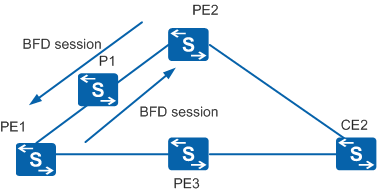BFD for MPLS LSPs
A BFD session established on an LSP can quickly detect faults and provide end-to-end protection for the LSP. When a BFD session is associated with a unidirectional LSP, the reverse link can be an IP Link, an LSP, or a TE tunnel. Both static and dynamic BFD sessions can monitor the connectivity of MPLS LSPs. Dynamic BFD sessions support only dynamic LSPs. Static BFD sessions support static and dynamic LSPs.
To monitor connectivity of an LSP, the ingress and egress nodes periodically send BFD packets to each other. If the ingress or egress node does not receive BFD packets from the other end within the specified period, BFD considers the LSP as Down and sends an LSP Down message to the LSP management module (LSPM).
Application
In Figure 1, only traffic from PE1 to CE2 is considered. When a fault occurs on the link between PE1 and P1, PE1 can detect the fault through its interface connected to P1. When a fault occurs on the link between P1 and PE2, PE1 cannot detect the fault through its interface connected to P1. BFD for dynamic LSPs needs to be configured to quickly detect faults.
A dynamic LSP destined for PE2 is set up on PE1. BFD for dynamic LSPs is enabled and a BFD session is set up. Additionally, policies of Virtual Private Network fast reroute (VPN FRR) are configured on PE1, and the protection path between PE1 and PE3 is specified. When a fault occurs on the link between PE1 and P1 or between P1 and PE2, PE1 fast detects the LSP fault and triggers VPN FRR switching. Traffic is then switched to the PE1 -> PE3 -> CE2 path.
